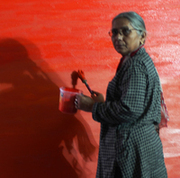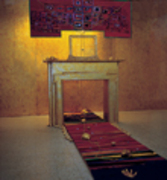GOGI SAROJ PAL
Gogi Saroj Pal a Contemporary Indian Artist
I works in different mediums .... installation, painting, sculpture, graphic prints,ceramics, jewelry, weaving, photography, computer, writing & limited edition books to achieve creativity.
Boi-data
Notifying Visitors of Site Enhancements
Getting Rich Quick--From My Site!
Gogi Saroj Pal a Contemporary Indian Artist
Gogi Saroj Pal: All these flowers are for you !
Robbina Karode
The visual exuberance of flowers carpeted on canvas, is of course instantly striking in Gogi Saroj Pal’s recent works, but there are secrets within that are not as immediately revealed.
Women and flowers share many metaphors- of beauty, delicacy, sweetness, fragility, perfume, embellishment, eroticism and sensuality. In her image making, Gogi has made a shift from her composite mythic imagery such as the bird form in Kinnari and the cow in Kamdhenu, but continues to express the ‘experiences of the feminine’. She has always believed that living traditions need to be challenged and hence had painted Indian traditional nayikas (heroines) transformed by her through the insertion of fantasy, desire and satire. Gogi has painted the features of her ethnic female in different skin shades to highlight her experiences of living in different regions of
In the present series, Gogi locates her nayika amidst the full-blossomed nature that seems a perfect place for retreat from the hectic world into a self-possessed space. For Gogi as a modern woman who herself relocated from a small village in Himachal to the urbanity of
The sensuousness of form, the dazzle of rich colours, transparency of garments, the half concealed sexuality- all accentuated the beauty of the female form and the romance of life in Indian art. In this series, Gogi has dressed her heroines in the popular
Gogi was trained in both the local mural tradition at the Gandhian school- Vanasthali Vidyapith in Rajasthan (1961) and at Lucknow School of Art and Craft, (1962- 67) which was strongly entrenched in academic naturalism of the West. Thus exposed early to disparate forms of artistic training, one that emphasized mimesis and the other the inner rupa or ideal form, she learnt expressional strategies of both conceptual and perceptual modes of artistic creation. She chose her freedom as a freelance artist over a teaching career primarily for the disregard that she had for those of her teachers who prescribed art making and suppressed her creative instincts. In her pursuit of art, she was neither limited by medium or by the challenge of new materials. In fact, she had a special knack of understanding the instinct of the materials and felt equally at ease learning craft and a sense of intuitive design from potters and weavers.
Gogi carried this uninhibited passion for transgressing the boundaries of formal learning to integrate with the larger artistic culture. She remembers how the concept of these paintings evolved out of learning that some mummies excavated in
Perhaps there comes a time in an artist’s life when the lonely journey and isolation from the world evokes a desire to connect or collaborate with the larger context and community in ways integral and meaningful to his/her work. The deliberate inclusion of “you” in the title by Gogi addresses no one specific- its nameless and faceless presence resonates to belong to any time, place, colour or origin. Like this, Gogi invents means for collective expression and experience and in the fabric base, connects with absent names of unknown makers, using their product as raw material and include their presence into her work as well. Gogi takes the enterprise even further. Instead of starting work on the blank canvas, she chooses to touch the untreated canvas by pasting a fine fabric with dense floral patterns on it and then make space for painting. Says Gogi, “I have trained for decades to work on the empty canvas and am well equipped to work out visual imageries in my mind… but to enter the dense space of fabric with an existing strong design on it is quite challenging.” Intervening within the given, she interprets the space, learning to co-exist with other presences and connections.
The experimentation has been quite an emotionally engaging process. She follows a series of sequential activities- from hunting for the right quality fabrics in the export markets, understanding lesser-known dimensions of the textile industry and learning how local markets consume surplus. Gogi has for long been aware of how textiles from
In these works one finds, that Gogi has intelligently played around with the ‘painted’ and ‘printed’ fabric, often challenging the viewer to identify one from the other. Inventing strategies of camouflaging and illusioning, she has often overpainted and highlighted parts through sensual touches on the fabric to tone it to her desired effect. Thickness of the fabric and its fine quality play a determining role here in layering the acrylic touches. At times, she uses a strategy of reversal, turning the body into fabric and often the fabric into body mass. For instance in the blue painting, while the actual presence of the fabric and its colour is retained on the body of the woman, it is subtly layered with paint all around to evoke a blue mood. Using corrective procedures, Gogi creates a delicate and soft separation of the figure and the background, which is otherwise the same in pattern and colour.
Gogi simultaneously addresses the issue of perspective- the relation of figure and ground/space in her paintings. She circumvents the scientific for the poetic in the posturing of the figures, as they dream, recline, bend over, stretch out and are zoomed in and out on a single plane amidst the rich foliage, much in the Indian folk tradition. And then we have the woman sewing flowers in a garland or to wear in her hair as ornamentation, their aroma being known to arouse passion. In one, she has even used the physical thread and actual needle in the work, ready as if to bring together the scattered flowers in a single thread. Most interestingly, in one of the works, Gogi tricks us by her wit, articulating the woman behind the printed flowers on the surface. She blurs some printed portions and paints the woman in a pale white transparent garment. The projected flowers behave as a curtain from which she peeps through. At times, she uses the same flower of the print and transforms it in her hairdo, her dress, dupatta and the backdrop. And then there is a work that creates the night ambience, the darkness hiding all from sight, except the woman’s face, caught in a moment of waiting and longing. Once again, the woman is emerging from behind the printed flowers, improvised and accentuated by the rare touches of her brush. In another work, Gogi tries out the magic of yellow on yellow, and the flowers she is sewing are called parijatak which is a white flower with an orange stem, highly perfumed and offered to the gods in puja (ritual of worship). Yet in another, there is a butterfly romancing the flowers on the fabric, fluttering close to her body affirming feminine attraction.
For Gogi, who diligently adheres to her creative instinct and experimental temperament, this new alliance between the printed and the painted may lead to newer and fresher forms of co-existence and connections…to embroider we hope, processes of life and art.
Roobina Karode,
Art Historian
Winter 2004,
Copyright, Roobina Karode

